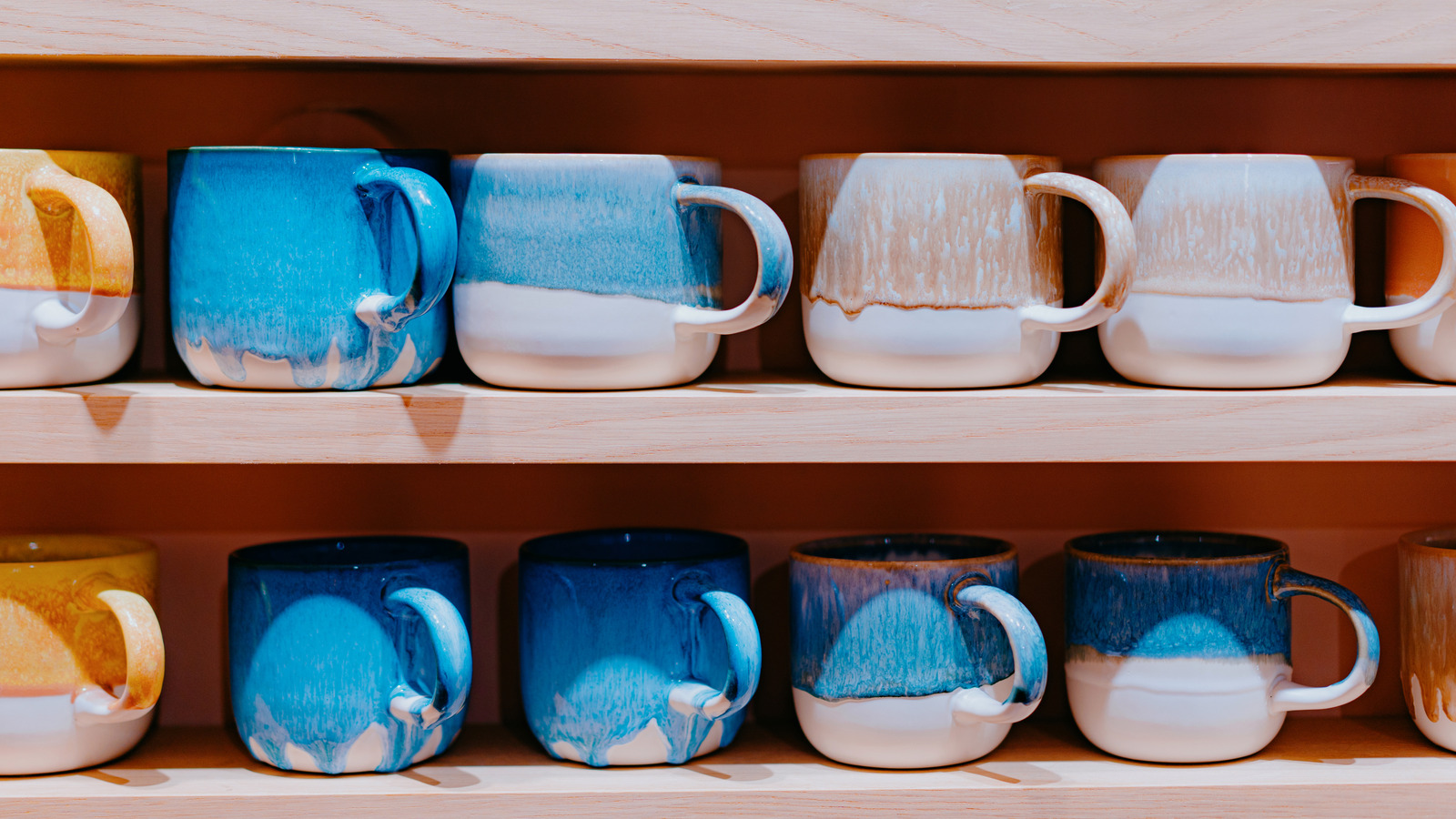Mugs seem to be the gift that overstays its welcome before long. Sure, there’s always a treasured few that you use with habitual regularity, but the abandoned stacks of mugs that well-meaning but distant relatives and cheery souvenir shops have contributed to over the years will continue to take up stagnant space in your kitchen cabinet unless you gird your loins and find some way to revitalize them.
We’ve compiled a comprehensive list of ideas that can easily resolve the pile of mugs that could once be seen as a Sisyphean task to be rid of. DIYers will be glad to hear that there’s a variety of projects in which old mugs can easily be implemented, and gardening enthusiasts will also get their day in the sun with the vast spread of horticultural ideas that star surplus mugs. As it takes only a few arts and crafts supplies to pretty up what was once seen as a cliche gift, mugs can easily be transformed into functional, beautiful decorative pieces that design-conscious homeowners will be sure to appreciate. Don’t worry; those who don’t quite fit into the aforementioned categories are still sure to find a few tailor-made ideas to help you empty out your cabinets for good.
Use surplus mugs to organize your odds and ends
As storage, mugs are surprisingly handy. Not only are they durable, but their portable size and handles make them easy to carry around wherever they’re needed. Any room in the house will benefit from a few mug organizers; keep your toothbrushes, Q-tips, and cotton swabs tidy in your bathrooms. In the kitchen, store your coffee pods, straws, or sponges on your counter for easy access. Vanities can benefit from a few elegant mugs containing makeup brushes and other tools to keep them clean. Your office desk can also use a pen holder for loose stationery, and coffee tables are great places to store mugs containing various odds and ends for a visual effect.
Because mugs were originally designed for drinking, their open tops make it easy to grab whatever’s inside. When repurposing your old mugs for storage, consider what it is that you reach for the most. Whether it’s bookmarks for your reading nook, nuts and bolts in the garage, or useful utensils for the kitchen, personalize your space with surplus mugs to not only declutter your space but also simplify your future personal endeavors. If you’re design-conscious, consider the aesthetic of the room in which you’re planning on placing your mug organizers and find the most appropriately styled cup for the area.
Make some homemade mug candles
For anyone feeling crafty, this one’s for you. Mug candles are an aesthetic and functional way to breathe new life into your abandoned cups. They’re relatively quick and simple to make, and they make great gifts for holidays, birthdays, and other special occasions for those who appreciate handmade gifts. Plus, if you use a food-safe wax for your candle, such as coconut oil or beeswax, you can resume drinking from your mug once the candle is used up, or make another candle!
Be sure to choose a sturdy mug to avoid any exploding cup horror stories. Ideally, mugs that aren’t painted or prone to cracking due to thermal shock are the best for any candle-making projects. Avoid using any decorative mugware and look for those intended for kitchenware. We recommend popping any potential candle mugs into the oven to see if they can hold up under extreme heat; ceramic or enamel mugs, for example, can be perfect for this activity due to their heat resistance and overall sturdiness. As always, be careful when lighting your candle; mugs can only hold so much fire!
Replace your disposable party cups with extra mugs
It’s a tale as old as time. Your party’s in full swing, your guests are enjoying themselves, the batch party cocktails are flowing freely, and then disaster strikes. The last of the plastic party cups are gone, and people are still thirsty. No fear, the party’s not yet over. Any extra mugs that you happen to have on hand can be used as party cups! Not only do you reduce the amount of trash you have to inevitably clear out the next morning, but these mugs can also be a great conversation starter among friends and family. Just remember to prep them beforehand by giving them a good wash and arranging them for easy access.
If you’re planning an event and are concerned about appearing disorganized or scattered with your various mug presentations, consider embracing a mug theme for your party. Host an event where your guests are welcome to bring their own surplus mugs, exchange them with other guests, or share anecdotes in a more familiar setting. Upcycle your extra mugs together, make a few mug candles, or bake a few mug cakes. The world is your (mug) oyster.
Create beautiful and unique mosaic art
Not all mugs are created equal. Some might not survive the ravages of time as well as their sturdier counterparts, and inevitably, you’ll find some of your mugs chipped, scratched, or badly damaged to the point where they’re not safe to handle in the house. However, you don’t have to head over to the trash bin just yet; there are still many ways to preserve the pieces of your late great mugs, and one of them includes using these pieces to make beautiful and unique mosaic art for your home. With a little love, care, and some pre-mixed mosaic grout, you can beautifully revitalize what remains of your favorite mugs.
You don’t have to be professionally crafty to make a lovely piece of mosaic art. You can plan out a general sketch for your design if you have a more complicated vision in mind, but if you just want to go down a simpler path, arrange the pieces as you wish. If your mug pieces are not the right size for your project, place the pieces inside a towel-wrapped plastic bag and gently smash them with a hammer until they fit into your design. If you have multiple chipped or broken mugs that you plan to fit into your mosaic art, you can have more of a color palette to play with in your creation process.
Turn broken mugs into unique jewelry
Similarly to how broken drinkware can find new purpose in a piece of handmade mosaic art, broken mugs can also be transformed into unique jewelry in a pinch. Depending on the size of your chosen mug, you can easily create a whole set of accessories from the broken pieces based on their size, shape, and design.
Because no broken mug is ever the same, what you will create will be uniquely and personally yours. As such, this “broken pieces” jewelry can make thoughtful (and frugal) gifts for family and friends. The pendant necklace made from the shards of a cup that endured through a marriage would be perfect for an anniversary gift. A pair of colorful earrings made from a gag gift from a friend is sure to get a few laughs during a send-off or as an entry in a white elephant exchange. You know yourself and loved ones best; don’t be afraid to get creative with how you repurpose and design your new accessories.
Brighten your garden with mug-made features
In a time of increasing modernity and urbanism, cultivating a unique gardening space can be a challenge. The difficulty of balancing function and aesthetics in a backyard, garden, or even a windowsill full of homegrown herbs varies from person to person, especially for those with a limited budget, but money does not have to be an obstacle. Repurposing various household items to contribute to your outdoor space is not only economical but can also lend a rustic, old country flair to your garden. Upcycling old mugs for outdoor purposes is just one way to accomplish this.
Old mugs can serve a variety of horticultural and visual purposes. Functionally, old mugs with chipped or cracked edges can be used to serve as useful planters for your plants. Aesthetically, rustic designs such as old, lightly used household items (including dishware and glassware) can give your outdoor space a touch of cottagecore coziness, which is an emphasis on minimalist, country living that gained popularity during the pandemic. Using old mugs, especially earthenware or plain ceramics, as design features will really personalize your natural spaces.
Convert mugs with broken bottoms into planters
If you’re a green thumb who’s less interested in the design and visual aesthetic sides of gardening, there are still ways to implement old mugs into your garden or greenhouse. Planters, especially those with quality, can be expensive, and using old mugs as planters can be a frugal alternative to spending hundreds on an overpriced store variety. While planter mugs are certainly limited in their storage capacity (no chance of fitting an olive tree inside of the average mug, after all), they’re still incredibly useful for housing small, low-maintenance house plants like succulents. Plus, if your mugs lean towards color and vibrance, the contrast between cup and plant is sure to be a visual attraction.
As we’ve mentioned previously, broken mugs work best for this purpose, especially those with cracked or missing bottoms. If your mug of choice doesn’t have any holes in the bottom, a drill with a small bit can easily make a few drainage holes in the bottom. Once you’ve filled your new-but-not mug planters, it’s only a matter of time before your drab windowsill becomes enlivened with a touch of natural vibrance and coziness.
Make a DIY bird feeder
Giving Mother Nature a home in your living space is still achievable without green thumbs, and this project is a perfect example. If you want to join over 59 million people across the country who enjoy giving their local birds a spot to eat and rest, the process is relatively simple compared to the other projects in this list. Any intact mug works as a bird feeder, and you don’t need to prep the mug in any way for this purpose.
Most of your preparation time will likely be spent preparing what goes inside your mug feeder, which you’ll need to undertake before hanging up your mug planter. While a diverse mix of bird-friendly seeds will attract the most variety of birds, hobbyists recommend preparing suet, little patties made from mixing animal fat like lard or tallow, seeds, and insects for your birds. Suet will harden inside the mug’s containers, ensuring that the mixture stays secure inside the feeder while simultaneously preventing other opportunistic animal thieves from pilfering the goods.
Once you’re ready to set up your feeder, make sure to hang the mug of choice in an accessible location for your local robin to munch from. Several DIYers have suggested using carabiners to hang their mug feeders from their trees or eaves, while others recommended securing theirs with jewelry wire, twine, or string.
Use as part of a gift kit
Gifting mugs on their own is becoming increasingly unwanted due to how often they’re gifted by well-meaning acquaintances. After all, there are only so many cups that can fit inside an average kitchen cabinet, and over the years, mugs can really pile up. However, if done right, gifting mugs as part of a set is far more personal and attractive than just the mug on its own. With some planning, thought, and creativity, bundling a mug as part of a themed set will no longer be seen as a cliché but rather something uniquely personal.
When assembling a mug gift set, it’s important to feature a theme to ensure cohesiveness. A bookworm may enjoy a bundle featuring bookmarks, bookstore gift cards, or personalized book embossers alongside their mugs. If the weather’s beginning to get nippy, go with a hot chocolate theme to maximize holiday coziness, or pack some pre-measured baking ingredients for a simple and delicious mug cake. A get-well-soon gift box can also be perfect for those recovering from colds, operations, or even after welcoming a new baby. Like with most personalized gifts, what’s important is considering the giftee’s interests and needs, and giving them a new mug gift set is just one way to show them you care.
Make your own unique light fixture
If you’re looking to add a little more light to your life but aren’t willing to brave the trip to your local furniture store, this project is for you. There was a time when DIY teacup lights were all the rage, but mugs can just as easily be repurposed into light or lamp shades. All that’s left to do is to find some light bulbs and wiring to make the light fixture of your dreams. Light fixtures featuring coffee cups, mugs, or just any old tankard as part of their design will add additional flavor to a themed coffeehouse or bar.
Tweak some glass mugs for a classically elegant look, or attach a saucer to its cup to give the design some depth. Arrange matching sets of mugs for a symmetrical, cohesive design, or vary it up by intentionally choosing random cups to color your space with an abstract look. The opacity of your mug will determine what kind of beam you’re going to get from your light, so just be sure to keep that in mind when arranging your design.
Decorate your home
Tableware has been an important feature in home design for centuries. China cabinets, Welsh dressers, and sideboards are all examples of furniture designed specifically to display heirloom dishware, expensive china, and other beautiful dining knick-knacks. While old mugs won’t exactly hold a candle to grandmother’s family Gzhel teaware, take a page from history and use these drinking cups as decorative features around your house. While you can certainly take your broken and less appealing mugs to make mosaic art or feed the birds, reserve your most beautiful and intricate mugs — the kind that will be sure to draw your guests’ attention and admiration — and put them on display.
While displaying mugs on their own is certainly acceptable, don’t be afraid to gussy up your cup to make it even more stunning. DIY YouTuber Totally Dazzled suggests adding rhinestones to a mounted mug to set it apart from ordinary drinkware. The mug will be transformed from an ordinary cup to something extravagant and tasteful, such as a vase for holding short-stemmed flowers, or featuring in the middle of your dining table as a centerpiece. Mugs with simple designs and minimal colors are perfect blank canvases for glowing up into a beautiful complement to your home.
Bring a mini ecosystem to life in a mug terrarium
Even before lockdown forced folks to find ways to keep themselves accommodated indoors, terrariums featured prominently in the homes of those who want to enjoy the beauty of nature’s flora but eschew the space, time, and effort it takes to maintain a costlier outdoor space. Simply put, a terrarium is a miniature garden kept inside a transparent container, often glass, where you can grow all sorts of tiny plants. Terrariums can be extravagantly elaborate or as simple as placing a few tiny succulents in a glass cup or, yes, an old mug.
While glass mugs aren’t common due to the material’s inability to handle raging hot temperatures, a transparent container such as a Mason jar mug is best for seeing inside the mini ecosystem that thrives in a terrarium. Tiny plants that don’t need a whole lot of sunlight, like miniature cacti or succulents, are great options for your terrarium. Ensure that your mug of choice is sizable enough to fit in all the extra decorative features that a proper terrarium would benefit from, such as moss pieces, gravel, seashells, or whatever best fits the theme of your design.
Donate your old mugs to a good cause
You’ve gone through the entirety of your mug cabinet, and you’ve managed to repurpose or DIY the majority of them into unique gifts and projects. But what about those last few strays that you just can’t find a purpose for? These could be oddly shaped, unassuming, or just plain tacky. However, even these oddballs can find a new purpose in life.
Let’s face it. Not everyone is privileged enough to have a surplus of unused mugs just lying around their house. It’s a first-world problem, for sure, but we can do our part to turn this little frustration into someone else’s support. There are a variety of charities and non-profit organizations that are always on the lookout for extra dishes or tableware they can give to those who may need them. Pickup Please is just one example of an organization that accepts dishes to donate to their connected charities. They operate across the country, so check your local branch to see if they can reach you. There are plenty of other organizations that offer free donation pick-up services, so it only takes a few clicks or calls to get your unwanted dishware moving to someone who would appreciate it more.





